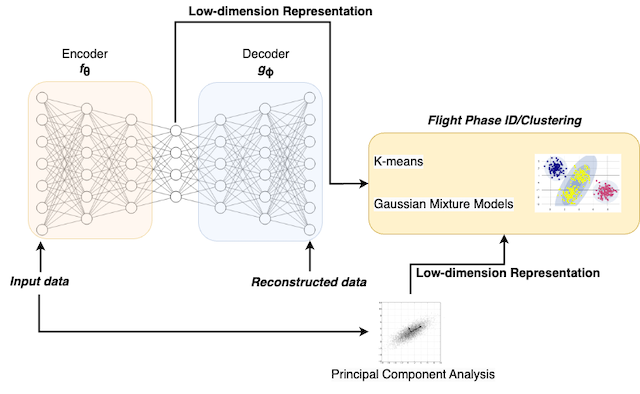DISC conducts research by developing and applying appropriate data science methods for engineering and physical sciences research, in collaboration with faculty, staff, and stakeholders within and outside Tufts University. Some of our current work focuses on uncertainty quantification, developing surrogate models for large simulations of hybrid rocket systems, machine learning tools for digital twins of energy infrastructures, and creating data science tools for aviation analyses. Below are some details about our current projects.
Jump to a Project
Combined Data and Model Form Uncertainty for Hybrid Rocket Experiments
 Flow of uncertainty information from the experiment ("Data uncertainty") to the model ("Model uncertainty") and how they combine to arrive at a probability distribution for the regression rate
Flow of uncertainty information from the experiment ("Data uncertainty") to the model ("Model uncertainty") and how they combine to arrive at a probability distribution for the regression rate
Collaboration between DISC (Abani Patra and Georgios Georgalis) and the Department of Mechanical & Aerospace Engineering, University at Buffalo, NY.
In complex physical process characterization, such as the measurement of the regression rate for solid hybrid rocket fuels, where both the observation data and the model used have uncertainties originating from multiple sources, combining these in a systematic way for quantities of interest (QoI) remains a challenge. In this work, we present a forward propagation uncertainty quantification (UQ) process to produce a probabilistic distribution for the observed regression rate. We characterized two input data uncertainty sources from the experiment (the distortion from the camera and the non-zero angle fuel placement), the prediction and model form uncertainty from the deep neural network, as well as the variability from the manually segmented images used for training it. We conducted seven case studies on combinations of these uncertainty sources with the model form uncertainty. The main contribution of this paper is the investigation and inclusion of the experimental image data uncertainties involved, and how to include them in a workflow when the QoI is the result of multiple sequential processes.
For more information contact Georgios Georgalis
References:
- Georgalis, G., Retfalvi, K., DeJardin, P.E., and Patra, A., 2023. “Combined Input Data and Deep Learning Model Uncertainty: An Application to the Measurement of Solid Fuel Regression Rate,” International Journal of Uncertainty Quantification, Vol. 13, No. 5, pp. 23-40. [View PDF]
- Surina III, G., Georgalis, G., Aphale, S.S., Patra, A. and DesJardin, P.E., 2022. “Measurement of hybrid rocket solid fuel regression rate for a slab burner using deep learning.” Acta Astronautica, 190, pp.160-175. [View PDF]
Machine Learning Methods for Offshore Wind Energy Infrastructure
Collaboration between DISC (Anna Haensch) and Tufts Electrical and Computer Engineering, Tufts Civil and Environmental Engineering.
Offshore wind is a vital component of the clean energy transition which is rapidly gaining momentum. In this work we consider offshore wind as a sociotechnical system by combining aspects of mechanical engineering and structural dynamics with signal processing and physics-informed machine learning to build out a complex system involving human agents and stakeholders. One component of this work involves structural health monitoring of offshore wind turbines using structural dynamics and data obtained from a supervisory control data acquisition system. Our recent work with regularized hidden Markov models predicts turbine loads and imputes missing data. In ongoing work we consider broader model classes such as physics-informed hidden Markov models, Gaussian processes and neural networks. One explicit goal of this project is to connect turbine models to policy decisions and labor practices using agent based modeling.
For more information contact Anna Haensch
References:
- Haensch, A., Tronci, E., Moynihan, B., Moaveni, B., 2023. "Regularized Hidden Markov Modeling with Applications to Wind Speed Predictions in Offshore Wind." [Under review].
 Overview of a digital twin for wind turbine infrastructures. Both the internal and external layers are agent-based models, each with their own characteristics
Overview of a digital twin for wind turbine infrastructures. Both the internal and external layers are agent-based models, each with their own characteristics
Identification of Phases of Flight for General Aviation
Collaboration between DISC (Georgios Georgalis) and Department of Mechanical & Aerospace Engineering at the Oklahoma State University, Stillwater, OK.
Accurate identification of phases of flight is an essential step in many analyses such as airport operation counts, fuel burn modeling and estimation, and safety studies. Past research has focused primarily on using positional data together with logical rule-based decision-making or probabilistic-based decision making to identify the phases of flight. Many of these efforts note that the task of correctly identifying phases of flight is challenging, often requiring extreme fine-tuning of methods from flight to flight. In this work, we study how combinations of dimensionality reduction and clustering machine learning methods perform for clustering flight data records of General Aviation aircraft into the correct flight phases (climb, cruise, or descent) and create a scheme for accurate identification of these phases. We have so far used flight data from 32 cross-country flights from C-172 and SR20 single-engine aircraft.
For more information contact Georgios Georgalis
References:
- Fala, N., Georgalis, G., and Arzamani, N., 2023. “Study on Machine Learning Methods for General Aviation Flight Phase Identification”. Submitted to Journal of Aerospace Information Systems, Vol. 20, No. 10, pp. 636-647. [View PDF]
 Workflow for flight phase identification via clustering and dimensionality reduction
Workflow for flight phase identification via clustering and dimensionality reduction
2. Georgalis, G., and Fala, N., 2023. “Automated Identification of Phase of Flight via Probabilistic Clustering for General Aviation Operations,” AIAA Aviation ’23. [View PDF]
